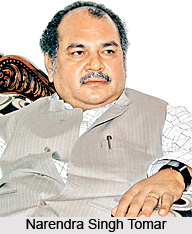 Narendra Singh Tomar is an Indian politician, presently in charge of the Ministry of Steel, Mines, Labour and Employment in the Cabinet of the 15th Prime Minister of India, Narendra Modi in the 16th Lok Sabha. He is the leader of Bharatiya Janata Party (BJP) and represents Morena constituency of Madhya Pradesh. Throughout his career he has also actively organized cultural, social and spiritual functions. Apart from this Narendra Singh Tomar also possesses literary interest and has organized poetic symposia for encouraging artists.
Narendra Singh Tomar is an Indian politician, presently in charge of the Ministry of Steel, Mines, Labour and Employment in the Cabinet of the 15th Prime Minister of India, Narendra Modi in the 16th Lok Sabha. He is the leader of Bharatiya Janata Party (BJP) and represents Morena constituency of Madhya Pradesh. Throughout his career he has also actively organized cultural, social and spiritual functions. Apart from this Narendra Singh Tomar also possesses literary interest and has organized poetic symposia for encouraging artists.
Early Life of Narendra Singh Tomar
Narendra Singh Tomar was born on 12th June 1957 in a village called Morar in the Gwalior district of the Indian state Madhya Pradesh. His parents Munshi Singh Tomar and Sharda Devi Tomar were a well off and well educated couple. Narendra Singh Tomar did his graduation from Jiwaji University.
Political Career of Narendra Singh Tomar
Narendra Singh Tomar has served as the President of Bharatiya Janata Party Youth Forum (BJPYF) in Gwalior since the year 1980 to 1984. From 1983 to 1987 he became the Councillor of Municipal Corporation in Gwalior, Madhya Pradesh. He was appointed as the Pradesh Mantri of BJPYF of the state from 1984 to 1985. Since the year 1986 to 1990 he was the State Vice-President of BJPYF while from 1991 to 1996 he got appointed as the State President of BJPYF. He was elected as the member of Madhya Pradesh Legislative Assembly for two terms from 1998 to 2008. He worked as the Cabinet Minister in the Government of Madhya Pradesh from 2003 to 2007. Since 20th November 2006 he is the President of BJP. He has been the member of Rajya Sabha since January 2009 to May 2009. In the year 2009 he was also elected to the 15th Lok Sabha and became the member of Committee on Chemicals and Fertilizers. In the year 2014 he became the Union Minister of Steel, Mines, Labour and Employment in the Cabinet led by Narendra Modi, the 15th Prime Minister of India. He was sworn in as the Union Minister on 26th of May 2014 by the President of India, Pranab Mukherjee.
Personal Life of Narendra Singh Tomar
Narendra Singh Tomar is married to Kiran Tomar and the couple is blessed with two sons and a daughter.




















